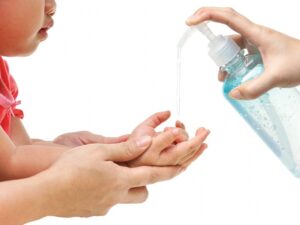Just when you think you’ve got this parenting thing figured out, new research comes along that refutes everything you’ve been doing since day one. If you’ve been debating the merits of flu mists, antibacterial soaps, and whether or not your kids should specialize in a singular sport, you’re in luck. Here’s the latest scoop to help you make the best choices for your family this season when it comes to shots, soaps, and sports.
Flu Shots
Last year’s flu season became one of the most severe seasons on record, according to the U.S. Centers for Disease Control and Prevention (CDC). Notably, of the 179 children who died of influenza-associated deaths, about 80 percent of them had not received a flu vaccination.
If you’re hoping to save your kids from the pain of a flu shot this fall, some parents opt instead for the painless nasal spray. However, a new policy statement from the American Academy of Pediatrics (AAP) recommends that all children ages six months and older receive the injectable flu vaccine as the primary choice (or the nasal spray vaccine as a secondary choice) during the 2018-19 flu season.
Previous research showed poor effectiveness of the flu mist compared with the traditional flu shot in recent flu seasons. That’s why the AAP recommends the flu shot as the most consistent protection against all strains of the flu virus.
For this year’s flu season, however, the AAP and CDC also support the use of the nasal spray vaccine–or live attenuated influenza vaccine (LAIV4). The goal? To provide the best protection and adequate vaccination coverage in children of all ages for the flu season.
“The effectiveness of the flu vaccine varies and is affected by factors such as the child's age, health status, vaccination history, and the strain of influenza circulating in a community,” says Henry Bernstein, MD, MHCM, FAAP, a member of the CDC Advisory Committee on Immunization Practices and an Ex-Officio member of the AAP Committee on Infectious Diseases. “We urge parents to talk with their pediatricians now to avoid any delay in getting their children vaccinated.”
Bottom line? Make sure your kids receive the flu shot as soon as possible.
Antibacterial Soaps
You can skip the expensive antibacterial soap the next time you’re stocking up on supermarket essentials and instead buy less expensive, plain ol’ soap. The U.S. Food and Drug Administration issued a statement that manufacturers can no longer market consumer antibacterial washes containing certain active ingredients, including the most commonly used ingredients–triclosan and triclocarban. Why? Because the manufacturers failed to demonstrate that the ingredients are both safe for long-term daily use and more effective than plain soap and water to avoid getting sick and to prevent spreading germs to others.
“Consumers may think antibacterial washes are more effective at preventing the spread of germs, but we have no scientific evidence that they are any better than plain soap and water,” says Janet Woodcock, M.D., director of the FDA's Center for Drug Evaluation and Research (CDER). “In fact, some data that suggests antibacterial ingredients may do more harm than good over the long-term.”
What do you do if soap and water aren’t available? The CDC recommends using an alcohol-based hand sanitizer that contains at least 60 percent alcohol.
Specializing in Sports
Even though you’ve been cheering on your soccer star since she was three with the hopes of her someday snagging a college scholarship, you might be doing her more harm than good.
According to a report from the AAP, young athletes who specialize in just one sport often face an increased risk of overuse injuries from their highly focused training. Plus, the athletes are more likely to experience stress and burnout from the singular focus and the pressure of performing.
In the report published in Pediatrics, lead author Joel S. Brenner, MD, FAAP, explains that “more kids are participating in adult-led organized sports today, and sometimes the goals of the parents and coaches may be different than the young athletes.”
The best advice? To minimize risk of overuse injury and boost the likelihood of being physically active into adulthood, the AAP encourages children to participate in multiple sports and delay specialization until at least 15 or 16 years of age. ■





